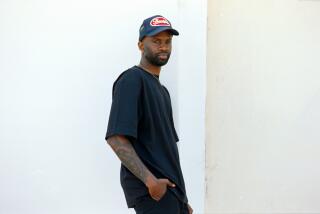Exhibit Focuses on Documentarian of Post-Depression N.Y. : By NANCY KAPITANOFF
In the 1930s, many New York photographers felt it was their duty to document the life of the cityâs less fortunate inhabitants surviving on the streets and in dilapidated, congested tenements.
Like the federal governmentâs Farm Security Administration photographers, who focused their lenses on the plight of rural Americans caught in the Depressionâs grip, the city photographers hoped to stimulate interest in improving the lot of working-class people.
Without the support of a government agency, these individuals came together in the Photo League. Formed in 1936 in New York, the organization provided socially conscious amateur and professional photographers with a place to share their ideas, expertise and friendship during a time when people still preferred to see dreamy pictorial landscapes and portraits of the good life.
Among the Leagueâs most well-known members was Paul Strand (1890-1976), who had moved away from pictorialism as early as 1917, when some of his photographs were published in Alfred Stieglitzâs publication, Camera Work. Monthly meetings featured guest speakers such as Ansel Adams and W. Eugene Smith.
Before the group folded in 1951--four years after the Leagueâs inclusion on a U. S. government list of so-called subversive organizations had caused its steady disintegration--an exhibition committee had organized solo shows of images by several photographers, including Henri Cartier-Bresson, Manuel Alvarez Bravo, Edward Weston, Weegee and Lisette Model.
Morris Huberland joined the Photo League in the early 1940s. Growing up on the Lower East Side, he had an affinity for photographing the people in the streets around him who were ill-housed, ill-clothed and ill-fed.
âI am by nature a loner. Photography is that kind of field,â said Huberland, 81, who was in last month for the opening of his solo show at the Stephen Cohen Gallery. However, he decided to become a League member because he needed some direction and the camaraderie of like-minded photographers. âWe became documentarians in photography when we barely had enough to eat, but we felt we had a mission to show the congestion, to reveal these things to the world.â
On view are more than 20 of his photographs taken between 1940 and 1960 in Spanish Harlem, the Lower East Side and the Bowery. Several of Huberlandâs images concentrate on the special joys and agonies of slum children.
One â40s picture captures a sandlot game, and another shows boys playing soldier with wooden sticks serving as their rifles. The boys in âHave a Butt, Lower East Sideâ (1947) wear knit hats and puff away on cigarettes.
âIf something strikes me, responds to my inner self, I react with my camera,â said Huberland, who still goes out on the streets of New York now and then to take pictures. Always visually minded, he bought a small box camera and developing kit when he was about 16, and took pictures of his family.
âI always annoyed my brother. I hung a blanket over the window to block out light, and he would yell at me how I was going to suffocate him,â he said.
When he was 18, his parents gave him about $50. With it he took a bus to Mexico and spent a few months there. He returned to New York with numerous pictures of Mexican people and street life. That trip convinced him to continue as a photographer despite his familyâs warning that he would never make a living doing it.
After one of his photographs won first prize in a contest to show how people were helping the war effort, he contacted various magazines, which began to give him assignments. He also shot photos for ads while he continued to document New York street life.
The girls in âGirl Group, Midtownâ (circa 1960), the scruffy, mixed-race kids of another image, and people in many of his photographs evoke nostalgia for simpler times despite oneâs awareness that life was not necessarily grand.
âThese are historical, emotional pictures. People respond to them right off the bat because of the period they capture,â said gallery director Stephen Cohen.
âMorris Huberland: Photo League Photographerâ is open 11 a.m. to 6 p.m. Tuesdays through Saturdays through April 10 at Stephen Cohen Gallery, 7466 Beverly Blvd., Los Angeles. Call (213) 937-5525.
More to Read
The biggest entertainment stories
Get our big stories about Hollywood, film, television, music, arts, culture and more right in your inbox as soon as they publish.
You may occasionally receive promotional content from the Los Angeles Times.










